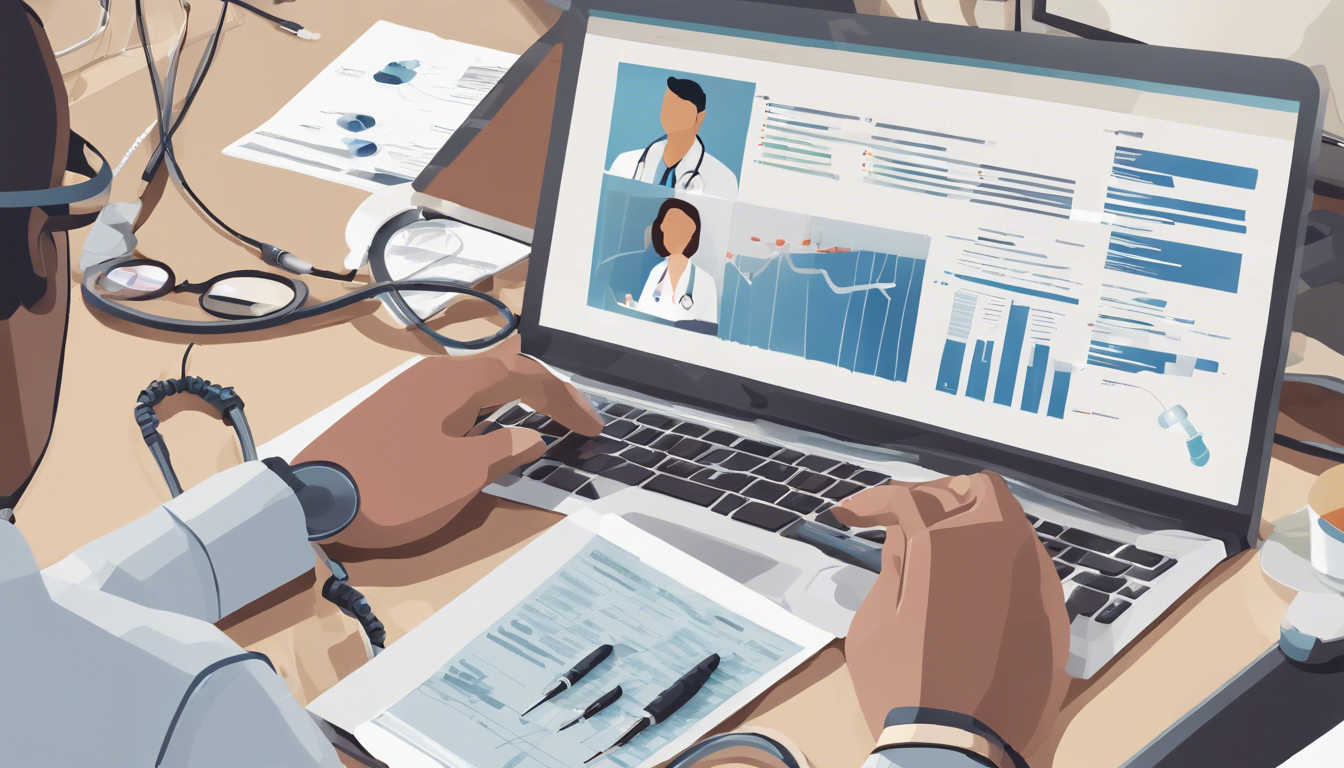In our rapidly evolving healthcare landscape, the transition from paper to digital is not just imminent; it’s essential. Electronic health records (EHR) stand at the forefront of this transformation, offering a more streamlined, efficient, and accessible way to manage patient information. The implementation of electronic health record systems has become a pivotal priority for healthcare providers worldwide, aiming to enhance the quality of care while ensuring security and compliance.
As we delve into the intricacies of EHR systems, it becomes clear that they are more than just digital versions of patient charts; they are a critical component in the modernization of healthcare, promising to reshape how we approach medical documentation, diagnosis, and treatment.
Throughout this article, we will explore the core features of digital health records, emphasizing the advantages they hold over traditional paper records. We will delve into the key technologies that power electronic health record systems, from epic electronic health record implementations to the broader spectrum of electronic healthcare records, and discuss the pivotal role they play in facilitating care coordination and improving patient outcomes.
Additionally, we will navigate the policy and regulatory considerations that govern the use of electronic medical health to ensure compliance and protect patient privacy. By providing a comprehensive overview of best practices for the implementation and utilization of electronic health record systems, we aim to equip healthcare providers with the knowledge needed to make informed decisions in their digital transformation journeys.
Core Features of Digital Health Records
In our exploration of the core features of digital health records, we focus on three primary types: Electronic Medical Records (EMRs), Electronic Health Records (EHRs), and Personal Health Records (PHRs). Each type serves a unique function and caters to specific needs within the healthcare system.
- Electronic Medical Records (EMRs) are primarily used within a single practice. They are the digital version of a patient’s medical history maintained by the provider over time, including diagnoses, medications, treatment plans, immunization dates, allergies, and test results.
- Electronic Health Records (EHRs) go beyond the data collected in EMRs. They are designed to be accessed and shared across different healthcare settings, facilitating better health outcomes through comprehensive, coordinated care. EHRs include all the information found in an EMR but also expand to include other key aspects of a patient’s clinical history.
- Personal Health Records (PHRs) are managed, shared, and controlled by the patients themselves, offering a comprehensive and accurate record of their health history accessible to them anytime and anywhere. PHRs integrate data from multiple sources, including healthcare providers and the patients themselves, providing a more holistic view of health that empowers individuals in their own care.
These systems not only streamline administrative processes but also enhance the accuracy of diagnoses, increase the efficiency of treatments, and improve the overall quality of healthcare delivery. By leveraging these digital records, healthcare providers can offer a more personalized and timely medical service to their patients.
Advantages Over Paper Records
Accessibility and Convenience
Electronic health records (EHRs) significantly enhance accessibility and convenience in healthcare settings. By providing accurate, up-to-date, and complete information about patients at the point of care, EHRs enable quick access to patient records for more coordinated, efficient care. This accessibility is crucial not only in routine clinical settings but also in emergency situations where timely information is vital.
Reduced Errors and Enhanced Safety
The implementation of EHRs plays a pivotal role in reducing clinical errors and enhancing patient safety. By facilitating better management of care for patients, EHRs help in reducing medical errors and ensuring safer care. They support diagnostic and therapeutic decisions through built-in safeguards against potential adverse events, significantly reducing the chances of medication errors and improving overall treatment outcomes.
Environmental Impact
The shift from paper to digital records also contributes to environmental sustainability. Digital health technologies, including EHRs, reduce the consumption of paper and the need for physical storage, thereby decreasing deforestation and waste. Moreover, by minimizing the need for physical transport of documents and enabling telehealth, EHRs contribute to reduced carbon emissions and lower overall environmental impact.
Key Technologies in Digital Health Records
In our exploration of the key technologies empowering digital health records, we delve into three pivotal areas: Cloud Computing, Artificial Intelligence, and Blockchain. Each of these technologies plays a crucial role in enhancing the functionality and security of electronic health records (EHRs).
Cloud Computing
Cloud computing has revolutionized the accessibility and scalability of EHRs. It allows healthcare providers to access patient data securely from any location, facilitating better coordination and efficiency in patient care. Key benefits include reduced operational costs due to minimal physical infrastructure needs and enhanced data interoperability among different healthcare systems.
Artificial Intelligence
Artificial Intelligence (AI) in EHR systems introduces capabilities such as predictive analytics, natural language processing, and machine learning, significantly reducing errors and improving patient outcomes. AI technologies can analyze vast amounts of data to provide decision support, optimize treatment plans, and predict patient risks with high accuracy. This integration not only streamlines workflows but also personalizes patient care by adapting to unique health profiles.
Blockchain
Blockchain technology offers a robust solution to the challenges of data security and interoperability in EHR systems. By creating a decentralized and tamper-proof database, blockchain ensures that patient records are secure and only accessible by authorized personnel. This technology supports transparent and efficient data sharing across different healthcare providers, enhancing privacy and trust in the digital handling of health records.
These technologies collectively enhance the digital landscape of healthcare, ensuring that EHR systems are not only more efficient and secure but also more aligned with the needs of modern healthcare delivery.
Policy and Regulatory Considerations
HIPAA Compliance
We recognize the importance of adhering to the Health Insurance Portability and Accountability Act (HIPAA), which mandates specific protections to safeguard electronic health information. These protections include access control mechanisms like passwords and encryption to secure stored information, and an audit trail to monitor access and modifications to patient data. Additionally, the HIPAA Security Rule establishes comprehensive security standards that health care providers must meet to protect electronic Protected Health Information (ePHI) through administrative, physical, and organizational safeguards.
Data Interoperability Standards
Interoperability remains a cornerstone of effective electronic health record systems, ensuring that various EHR products can seamlessly share information. Standards such as FHIR (Fast Healthcare Interoperability Resources) and DICOM for medical imaging, alongside coding systems like ICD-10 and HL7 V3, play crucial roles. However, the lack of a single unified standard poses challenges to achieving true interoperability. Efforts are ongoing to enhance data standards and support semantic interoperability, which is vital for the accurate interpretation and utilization of exchanged data across different systems.
Government Incentives and Programs
Government initiatives have significantly bolstered the adoption and meaningful use of EHR systems. The HITECH Act, for instance, has allocated billions in incentives to encourage healthcare providers to adopt and effectively use EHR systems. These incentives are tied to demonstrating meaningful use, which includes using certified EHR technology to improve quality of care and patient data exchange. Furthermore, the establishment of 62 Regional Extension Centers under the HITECH Act provides crucial support to healthcare providers, especially in primary care, to navigate the complexities of EHR implementation and compliance.
Conclusion
Throughout this exploration of electronic health record systems, we have highlighted their critical role in modernizing healthcare, from enhancing patient care coordination to ensuring data security and compliance with regulatory standards. The transition to digital records, powered by cloud computing, artificial intelligence, and blockchain technologies, not only streamlines healthcare processes but also offers unprecedented opportunities for improving diagnosis, treatment, and patient outcomes.
As we’ve delved into the core features of digital health records and their advantages over traditional paper records, it’s clear that the implementation of EHRs is a complex yet invaluable endeavor that requires careful consideration of policy, technology, and best practices.
The significance of adopting EHR systems extends beyond immediate operational efficiencies, touching on broader implications for patient safety, privacy, and environmental sustainability. It’s evident that as healthcare providers and policymakers navigate the challenges and opportunities presented by digital transformation, the path forward includes fostering interoperability, ensuring HIPAA compliance, and leveraging governmental incentives to facilitate the adoption of EHRs.
In doing so, healthcare providers can not only meet the demands of the digital age but also significantly impact the quality of healthcare delivery for generations to come, highlighting the indispensable role of electronic health records in shaping the future of healthcare.
FAQ on Electronic Health Records (EHR)
1. What are electronic health records (EHR)?
Answer: Electronic health records (EHR) are digital versions of patients’ medical histories that can be accessed and shared across different healthcare settings, facilitating comprehensive, coordinated care.
2. What are the advantages of EHR over traditional paper records?
Answer: EHRs enhance accessibility, reduce clinical errors, and contribute to environmental sustainability by minimizing paper use and physical storage needs.
3. How do key technologies like cloud computing, AI, and blockchain enhance EHR systems?
Answer: Cloud computing allows secure access to patient data from any location, AI improves diagnostic accuracy and treatment personalization, and blockchain ensures data security and interoperability.
4. What regulatory considerations are essential for EHR implementation?
Answer: Compliance with HIPAA regulations to safeguard electronic health information, ensuring data interoperability through standards like FHIR and ICD-10, and leveraging government incentives from programs like the HITECH Act are crucial.
5. How can healthcare providers benefit from government incentives related to EHR?
Answer: Government initiatives like the HITECH Act provide financial incentives to healthcare providers for adopting and effectively using EHR systems, which helps improve quality of care and patient data exchange.




